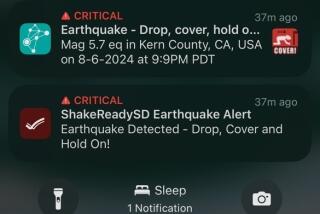Fog Sets Off Gas Detectors, Causing Scares : Weather: Moisture traps carbon monoxide close to the ground, triggering false alarms and generating more than 3,300 calls to authorities. Newer devices avoid the problem.
The thick fog that has blanketed parts of Southern California for more than a month has triggered more than 3,300 nuisance alarms from increasingly popular carbon monoxide detectors--a wave of alerts that has sent some homeowners into a panic and flooded the gas company with service calls.
The surge of alarm calls--nearly 100 times the normal number--has resulted from weather in which an inversion layer traps low levels of carbon monoxide close to the ground, according to the Southern California Gas Co. and BRK Brands, the largest alarm manufacturer.
“We have been going crazy,” one gas company technician said during a recent late-night call. “I’ve had 15 of these calls already today and at least two more before I’m done.”
The saucer-sized, ceiling-mounted carbon monoxide detectors sell for about $50 and have been on the market for a little more than two years. They are designed to alert residents to faulty stoves, furnaces and other gas sources that could be harmful or deadly. Sales have jumped since several high-publicity carbon monoxide poisoning deaths, including that of tennis star Vitas Gerulaitis last year.
But the technology for the in-home detectors is relatively new and standards are still being revised. BRK and Underwriters Laboratories, which sets industry safety standards, acknowledged earlier this year that the devices were detecting background levels of the gas, not just hazardous leaks.
Since October, BRK, which makes First Alert alarms, has been shipping to stores a new device that is not supposed to be activated by background levels of the gas that are found when some cities are socked in by fog.
In the meantime, many of the older devices remain in homes and are driving Southern California Gas Co. and fire department operators to distraction.
The gas company estimates that in November it responded to 2,500 calls from customers with carbon monoxide detectors that emitted their piercing wails despite the absence of an urgent problem. Many of those calls were from the San Fernando and San Gabriel valleys. An additional 809 nuisance calls were reported in the first six days of December, many from coastal Los Angeles and Orange counties.
In a typical month without a heavy inversion layer, the utility receives just 30 or 40 nuisance calls related to carbon monoxide.
South Coast Air Quality Management District officials say elevated levels of carbon monoxide are typical for winter. There have been 11 days since the start of November that the level of the gas, most typically produced by car exhaust, has exceeded the federally recognized healthful standard.
Winter atmospheric conditions can worsen symptoms in people with heart and lung ailments, although they typically do not trigger the kind of catastrophic problems that the detectors were meant to warn of.
The alarms often sound in the middle of the night or early morning--when the layers of cloud cover around Southern California are the thickest.
A gas company technician who recently responded to an alarm call reported that a young mother had taken her children and fled her home in a panic after her alarm went off--only to be told later by the gas company that the device had merely picked up background levels of carbon monoxide.
Anxiety can be exacerbated because it is impossible for untrained people to verify the presence of dangerous levels of carbon monoxide, which is invisible, odorless and tasteless.
“People are used to smoke detectors and they can look around and see smoke to get validation. But with these you don’t have that luxury,” said Martin Remmen, operations manager for the gas company in the Canoga Park area. “People can jump up and be nervous, but there is no way for them personally to validate.
“We treat these calls with a good amount of seriousness, because of that unknown aspect,” Remmen added.
BRK, which sells sells about three-quarters of the carbon monoxide alarms on the market, says the devices are not emitting “false” alarms but merely giving an early warning of a condition that could become hazardous if not monitored.
The gas company, which serves all of Southern California, says customers must take the alarms seriously. Though there has been a high number of nuisance reports, some of the alarms have detected legitimate carbon monoxide leaks, Remmen said.
As of Oct. 1, Underwriters Laboratories has required that the devices ignore low concentrations of carbon monoxide. Now, the devices must detect up to 15 parts per million of the gas for at least 30 days without sounding an alarm. Previously, the alarms would sound if that concentration was detected for just eight hours.
“In essence, an inversion layer won’t make the detector go off anymore,” said Debbie Hanson of BRK Brands.
(BEGIN TEXT OF INFOBOX / INFOGRAPHIC)
Safety Tips
Carbon monoxide alarms have been going off in record numbers for the past month, mainly ecause of a fog blanket holding pollutants close to the ground.
Homeowners are advised to take the alarms seriously. When a carbon monoxide detector sounds, the owner should do the following:
* ventilate the home or structure immediately by opening doors and windows;
* turn off gas appliances;
* check occupants of the building for dizziness, nausea or flu-like symptoms;
* if anyone is ill, evacuate the building immediately;
* call the gas company or another qualified technician to assure that gas appliances are functioning properly.
Southern California Gas Co. has pledged to respond as soon as possible to calls from residents who feel ill. In cases where there is not an illness, an inspection usually can be made the same day.
Source: Southern California Gas Co.
More to Read
Sign up for Essential California
The most important California stories and recommendations in your inbox every morning.
You may occasionally receive promotional content from the Los Angeles Times.











